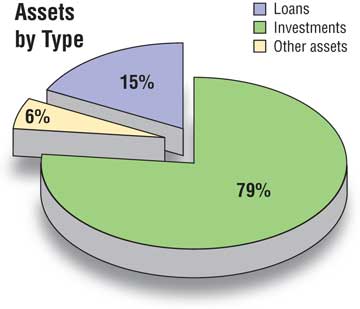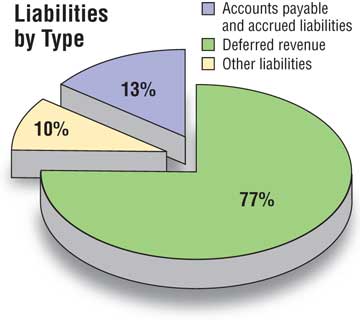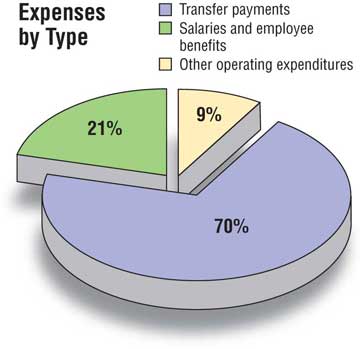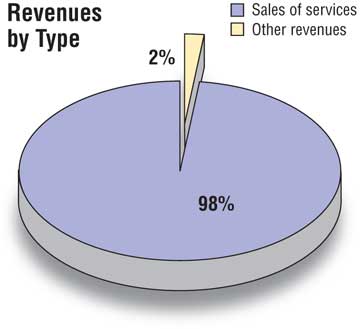Common menu bar links
Breadcrumb Trail
ARCHIVED - Industry Canada
 This page has been archived.
This page has been archived.
Archived Content
Information identified as archived on the Web is for reference, research or recordkeeping purposes. It has not been altered or updated after the date of archiving. Web pages that are archived on the Web are not subject to the Government of Canada Web Standards. As per the Communications Policy of the Government of Canada, you can request alternate formats on the "Contact Us" page.
Section 3: Supplementary Information
3.1 Financial Highlights
The future-oriented financial highlights presented within this Report on Plans and Priorities are intended to serve as a general overview of Industry Canada's financial position and operations. These financial highlights are prepared on an accrual basis to strengthen accountability and improve transparency and financial management.
Future-oriented financial statements can be found on IC's website.
| (in millions of dollars) | % Change | Forecast 2010-11 |
Estimated Results 2009-10 |
|---|---|---|---|
| Condensed Future-oriented Statement of
Financial Position (unaudited) At March 31 |
|||
| ASSETS | |||
| Financial Assets | 6 | 3,559 | 3,366 |
| Non-Financial Assets | 3 | 122 | 118 |
| TOTAL | 6 | 3,681 | 3,484 |
| LIABILITIES | |||
| Accounts Payable and Accrued Liabilities | 0 | 650 | 650 |
| Deferred Revenue | -13 | 3,795 | 4,374 |
| Other Liabilities | 1 | 502 | 498 |
| Total Liabilities | -10 | 4,947 | 5,522 |
| EQUITY | -38 | (1,266) | (2,038) |
| TOTAL | 6 | 3,681 | 3,484 |
| Condensed Future-oriented
Statement of Operations (unaudited) For the period ended March 31 |
|||
| EXPENSES | |||
| Transfer Payments | -19 | 1,754 | 2,178 |
| Operating Expenses | -17 | 744 | 894 |
| Total Expenses | -19 | 2,498 | 3,072 |
| REVENUES | |||
| Sales of Services | -1 | 1,079 | 1,092 |
| Other | -28 | 21 | 29 |
| Total Revenues | -2 | 1,100 | 1,121 |
| NET COST OF OPERATIONS | -28 | 1,398 | 1,951 |
Total assets are projected to be $3.681 billion for fiscal year 2010–11. The largest asset is the investment in the Business Development Bank of Canada (79% or $2.897 billion). The balance of the asset account consists of loans (15% or $560 million) and other assets (6% or $224 million) which consist of accounts receivable and advances, tangible capital assets, and prepaid expenses. The 6% variance in assets can be explained by the forecasted investment in the Business Development Bank of Canada in fiscal year 2010–11.
Total liabilities are projected to be $4.947 billion for fiscal year 2010–11. The forecasted deferred revenue is the largest liability on the future-oriented statement of financial position (77% or $3.795 billion). This amount represents auction revenues that are deferred on a straight-line basis over 10 years, with a significant portion resulting from the Advanced Wireless Services and Other Spectrum auction that was held during fiscal year 2008–09. As the deferred revenues from the auction become realized as earned revenues, the liability decreases, thereby accounting for the 10% variance shown for the departmental liability. The balance of the liability account consists of accounts payable and accrued liabilities (13% or $650 million) and other liabilities (10% or $502 million).
Total expenses are projected to be $2.498 billion in fiscal year 2010–11. The majority of these expenses are in the form of transfer payments and contributions related to departmental programs and the implementation of Canada's Economic Action Plan (70% or $1.754 billion). The balance of spending is made up of salaries and employee benefits (21% or $514 million) and operating expenses (9% or $230 million). The majority of these latter expenses are required for the Department's policy, legislative and advocacy roles. The balance is made up of actual day-to-day operations under the program activity entitled “Internal Services.” The 19% variance in expenses can be explained by the initiatives that will be partially or fully transferred to the Federal Economic Development Agency for Southern Ontario. In addition, there is a forecasted decrease in transfer payments under the Commercialization and Research and Development Capacity in Targeted Canadian Industries program activity.
Total revenues are projected to be $1.100 billion for fiscal year 2010–11. Sales of services (98% or $1.079 billion) includes revenues recognized from previous years' spectrum auctions and forecasted revenues from licence fees. Other sources of revenue include Canada Small Business and Financing Program fees, fines, and their associated fees (2% or $21 million). Revenue from fines under the Competition Law Enforcement and Advocacy and the return on investment are forecasted to be lower in 2010–11 than 2009–10, which explains the 28% variance in other revenues.
3.2 List of Tables
List of Tables — Organizational Information
- Details of Transfer Payment Programs (TPP)
- Up-Front, Multi-Year Funding, formerly Foundations (Conditional Grants)
- Green Procurement
- Horizontal Initiatives
- Internal Audits
- Evaluations
- Sources of Respendable and Non-Respendable Revenue
- Summary of Capital Spending by Program Activity
- User Fees for 2010–11
Program Activity Titles and Descriptions
- The Canadian Marketplace is Efficient and Competitive
- Science and Technology, Knowledge, and Innovation are Effective Drivers of a Strong Canadian Economy
- Competitive Businesses are Drivers of Sustainable Wealth Creation
Expected Results Information for Program Sub-Activities and Sub-Sub-Activities by Strategic Outcome
- The Canadian Marketplace is Efficient and Competitive
- Science and Technology, Knowledge, and Innovation are Effective Drivers of a Strong Canadian Economy
- Competitive Businesses are Drivers of Sustainable Wealth Creation
3.3 Other Items of Interest
IM/IT Governance and Responsibilities at Industry Canada
Information Management (IM) and Information Technology (IT) continue to play an important role as strategic enablers of the Department's business. Effective stewardship of information and technology encompasses fiscal responsibility in meeting client needs and expectations for high-quality, authoritative information. The growth in volume and complexity of information has emphasized the need for continued vigilance to ensure IM/IT investment decisions are consistent with departmental priorities and provide high levels of service to Canadians.
Industry Canada is well positioned, with its multi-year Information Management (IM) Agenda, to ensure that departmental information is managed efficiently and effectively to support program and service delivery; foster informed decision making; facilitate accountability, transparency and collaboration; and preserve access to information and records for the benefit of present and future generations.
The desired outcomes of the IM Agenda are threefold: that Industry Canada has the requisite IM governance structure in place; that employees are aware of their IM responsibilities and know how to execute them; and that they are given the tools to help them do so. To meet these objectives, a series of IM projects have been identified and will be implemented in a phased approach.
Work on the multi-year IM Agenda will continue in 2010–11 with a focus on building capacity, delivering the corporate tools required to better manage information at the desktop and implementing an IM Governance and Accountability Framework. This will include supporting sectors in implementing the business-specific layer of the Enterprise Business-based Classification Structure and building IM Specialist capacity. In addition, a project will be initiated to develop a departmental information architecture to support solutions that cut across business and technological boundaries, as part of the departmental enterprise architecture; and, pending project approval, an enterprise Electronic Document and Records Management Solution (EDRMS) will be introduced.
The value of information is enhanced when it can be accessed and applied to accelerate decision making, and IT tools play a crucial role in providing the means to do this. The Department's new integrated planning process will improve the alignment of IM activities and technology directions.
Industry Canada's departmental IT governance structure provides the framework required for strategic decision making. Managing projects in an effective manner and ensuring alignment between departmental priorities and investments are senior management responsibilities with accountability to the Deputy Minister.
Under the guidance of departmental IT governance committees, Industry Canada ensures that departmental IM/IT investments are managed corporately and that they support departmental business objectives and priorities. Together, the committees are responsible for IM/IT procedures, policies, planning, investment decisions, project oversight and standards.
In 2010–11, the Department will focus on enhancing capacity to monitor and track the benefits of IT investments. This work will be done by the Departmental Project Management Office (DPMO), which is also responsible for reporting on the IT investment portfolio; supporting the IT governance committees in their oversight and decision-making roles; and providing advice, tools and professional development support to the project management community at Industry Canada.




